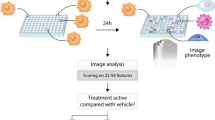Abstract
Kinases represent one of the most therapeutically tractable targets for drug discovery in the twenty-first century. However, confirming engagement and achieving intracellular kinase selectivity for small-molecule kinase inhibitors can represent noteworthy challenges. The NanoBRETTM platform enables broad-spectrum live-cell kinase selectivity profiling in most laboratory settings, without advanced instrumentation or expertise. However, the prototype workflow for this selectivity profiling is currently limited to manual liquid handling and 96-well plates. Herein, we describe a scalable workflow with automation and acoustic dispensing, thus dramatically improving the throughput. Such adaptations enable profiling of larger compound sets against 192 full-length protein kinases in live cells, with statistical robustness supporting quantitative analysis.
Access this chapter
Tax calculation will be finalised at checkout
Purchases are for personal use only
Similar content being viewed by others
References
Robers MB, Friedman-Ohana R, Huber KVM, Kilpatrick L, Vasta JD, Berger B-T, Chaudhry C, Hill S, Muller S, Knapp S, Wood KV (2020) Quantifying target occupancy of small molecules within living cells. Annu Rev Biochem 89:557–581
Vasta JD, Corona CR, Wilkinson J, Zimprich CA, Hartnett JR, Ingold MR, Zimmerman K, Machleidt T, Kirkland TA, Huwiler KG, Ohana RF, Slater M, Otto P, Cong M, Wells CI, Berger B, Hanke T, Glas C, Ding K, Drewry (2018) Quantitative, wide-spectrum kinase profiling in live cells for assessing the effect of cellular ATP on target engagement. Cell Chem Biol 25:206–214
Robers M, Dart M, Woodroofe C et al (2015) Target engagement and drug residence time can be observed in living cells with BRET. Nat Commun 6:10091
Robers MB, Vasta JD, Corona CR, Ohana RF, Hurst R, Jhala MA, Comess KM, Wood KV (2019) Quantitative, real-time measurements of intracellular target engagement using energy transfer. In: Methods in molecular biology, pp 45–71
Wells C, Vasta J et al (2020) Quantifying CDK inhibitor selectivity in live cells. Nat Commun. https://doi.org/10.1038/s41467-41020-16559-41460
Davies MI et al (2011) Comprehensive analysis of kinase inhibitor selectivity. Nat Biotechnol. https://doi.org/10.1038/nbt.1990
Karaman M et al (2008) A quantitative analysis of kinase inhibitor selectivity. Nat Biotechnol. https://doi.org/10.1038/nbt1358
Robers MB, Wilkinson JM et al (2021) Single tracer-based protocol for broad-spectrum kinase profiling in live cells with NanoBRET. STAR Ptotoc 2(4):100822
Cheng Y-C, Prusoff WH (1973) Relationship between the inhibition constant (KI) and the concentration of inhibitor which causes 50 per cent inhibition (I50) of an enzymatic reaction. Biochem Pharmacol 22:3099–3108
Newton P, Harrison P, Clulow S (2008) A novel method for determination of the affinity of protein: protein interactions in homogeneous assays. J Biomol Screen 13:674–682
Zhang J, Chung TDY, Oldenburg KR (1999) A simple statistical parameter for use in evaluation and validation of high throughput screening assays. J Biomol Screen 4:67–73
Eastwood BJ, Farmen MW, Iversen PW, Craft TJ, Smallwood JK, Garbison KE, Delapp NW, Smith GF (2006) The minimum significant ratio: a statistical parameter to characterize the reproducibility of potency estimates from concentration-response assays and estimation by replicate-experiment studies. J Biomol Screen 11:253–261
Haas JV, Eastwood BJ, Iversen PW, et al (2013) Minimum significant ratio – a statistic to assess assay variability. Assay Guidance Manual [Internet].
Author information
Authors and Affiliations
Corresponding author
Editor information
Editors and Affiliations
Rights and permissions
Copyright information
© 2023 The Author(s), under exclusive license to Springer Science+Business Media, LLC, part of Springer Nature
About this protocol
Cite this protocol
Nieman, A.N. et al. (2023). NanoBRET™ Live-Cell Kinase Selectivity Profiling Adapted for High-Throughput Screening. In: Merk, D., Chaikuad, A. (eds) Chemogenomics. Methods in Molecular Biology, vol 2706. Humana, New York, NY. https://doi.org/10.1007/978-1-0716-3397-7_8
Download citation
DOI: https://doi.org/10.1007/978-1-0716-3397-7_8
Published:
Publisher Name: Humana, New York, NY
Print ISBN: 978-1-0716-3396-0
Online ISBN: 978-1-0716-3397-7
eBook Packages: Springer Protocols




